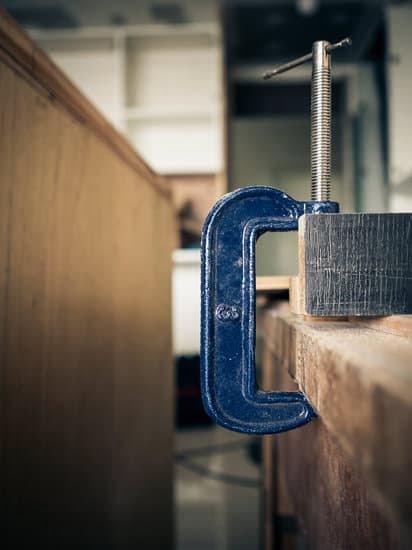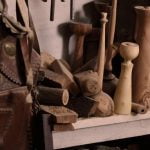Black mold can be a pesky and potentially dangerous problem when it comes to woodwork in your home. In this article, we will explore the ins and outs of black mold on woodwork, including how to identify it, safety precautions before removal, tools needed for the job, step-by-step removal process, prevention methods, when to call a professional, and tips for maintaining woodwork to prevent future infestations.
If you’re wondering how to remove black mold from woodwork, you’ve come to the right place.
Firstly, we will delve into understanding what black mold is and why it poses a threat to your home and health. Identifying the signs and symptoms of black mold on woodwork is crucial in order to take appropriate action in mitigating the issue. Additionally, we will provide insight on the necessary safety precautions that should be taken before embarking on the removal process.
Equipped with the right knowledge about black mold on woodwork and safety measures, we will then discuss the tools and materials needed for effective removal. A step-by-step guide will be provided for readers looking to tackle this task themselves. We’ll also cover important tips for preventing black mold from re-infesting your woodwork in the future as well as when it would be best to seek professional help for removal.
Identifying Black Mold on Woodwork
Woodwork can often be a hotbed for black mold growth due to its porous nature and the potential for moisture buildup. Identifying black mold on woodwork is crucial in order to take the necessary steps for removal. There are several signs and symptoms to look out for when inspecting woodwork for black mold.
Visible Growth
One of the most obvious signs of black mold on woodwork is the presence of visible growth. This can appear as dark, velvety spots or patches on the surface of the wood. Sometimes, black mold may also have a greenish or grayish tint to it.
Musty Odor
Another common indicator of black mold on woodwork is a musty or earthy odor. If you notice an unpleasant smell coming from your woodwork, especially in areas where there may be moisture or humidity, it could be a sign of hidden mold growth.
Allergy Symptoms
In some cases, individuals may experience allergic reactions when exposed to black mold. Symptoms such as sneezing, coughing, watery eyes, and skin irritation may indicate the presence of black mold in the surrounding environment. If these symptoms worsen when near woodwork, it may be worth investigating for mold growth.
By being aware of these signs and symptoms, you can more effectively identify black mold on woodwork and take appropriate action to address the issue. In the following sections, we will delve into safety precautions before starting the removal process and provide a step-by-step guide on how to remove black mold from woodwork.
Safety Precautions Before Starting the Removal Process
Before you begin the process of removing black mold from woodwork, it is crucial to take the necessary safety precautions to protect yourself and others in the vicinity. Black mold can be harmful if inhaled or if it comes into contact with skin, so ensuring your safety is paramount. Here are some essential safety measures to take before starting the removal process:
Safety Precautions:
1. Wear Protective Gear: Prior to tackling the black mold removal, make sure to wear protective gear such as gloves, goggles, and a respirator mask to prevent exposure to mold spores.
2. Ventilation: Ensure adequate ventilation in the area where you will be working. Open windows and use fans to help circulate air and prevent the buildup of mold spores.
3. Contain the Area: Use plastic sheeting and tape to seal off the work area from the rest of the house, preventing mold spores from spreading to other areas.
4. Dispose of Contaminated Materials Properly: Be sure to dispose of any materials that come into contact with black mold, such as rags or brushes, in sealed plastic bags and promptly remove them from your home.
By taking these safety precautions before initiating the removal process, you can minimize the risk of exposure to black mold and ensure a safer environment for yourself and those around you.
For an in-depth guide on how to remove black mold from woodwork safely, check our Step-by-Step Guide on How to Remove Black Mold from Woodwork section.
Tools and Materials Needed to Remove Black Mold From Woodwork
When it comes to removing black mold from woodwork, having the right tools and materials is crucial for a safe and effective process. Here is a list of essential items you will need to gather before starting the removal process:
- Protective Gear: Before getting started, make sure to wear protective gear such as gloves, goggles, and a mask to protect yourself from harmful mold spores.
- Cleaning Supplies: You will need cleaning supplies such as a quality mold remover or solution, warm water, a scrub brush, and a clean cloth or sponge.
- Plastic Sheeting and Tape: It’s important to section off the affected area with plastic sheeting and tape to prevent the spread of mold spores during the removal process.
- Vacuum Cleaner with HEPA Filter: A vacuum cleaner equipped with a HEPA filter can effectively trap and remove mold spores from the surface of the woodwork.
- Wood Sealer or Paint: Once the mold has been removed, consider using a wood sealer or paint to prevent future mold growth on the woodwork.
In addition to these items, it’s also important to have proper ventilation in the work area. Open windows or use fans to ensure good air circulation during the removal process. By gathering these tools and materials beforehand, you can prepare yourself for a smooth and successful black mold removal process.
Now that you have all your tools and materials ready, it’s time to proceed with step-by-step guidance on how to safely and effectively remove black mold from woodwork.
Step-by-Step Guide on How to Remove Black Mold From Woodwork
Prepare the Area
Before you start the process of removing black mold from woodwork, it’s important to prepare the area. This includes ensuring proper ventilation by opening windows and using fans, as well as wearing protective gear such as gloves, goggles, and a mask to prevent inhalation or skin contact with mold spores. It’s also advisable to cover surrounding furniture and flooring with plastic sheets to prevent the spread of mold spores during the removal process.
Scrubbing the Mold
Once the area is prepared, use a stiff-bristled brush to scrub the affected woodwork surface. You can use a solution of water and mild detergent or a commercial mold remover to help loosen and remove the mold from the wood. Take care not to use too much water, as excessive moisture can further damage the wood.
Drying and Sanding
After scrubbing the mold from the woodwork, thoroughly dry the area using clean towels or rags. Once dry, sand the wood surface lightly to remove any remaining traces of mold and to smooth out any rough areas caused by scrubbing. Be sure to dispose of any used materials properly to prevent spreading mold spores elsewhere in your home.
Following these steps along with proper disposal of contaminated materials can help in effectively removing black mold from woodwork while ensuring safety during the process.
Preventing Black Mold From Coming Back on Woodwork
Once you have successfully removed black mold from your woodwork, it’s crucial to take steps to prevent it from coming back. Mold thrives in damp and humid environments, so keeping your woodwork dry is key to preventing its return. Make sure to fix any leaks in the area where the woodwork is located, whether it’s a faulty pipe or a leaky roof. This will help eliminate any moisture that could lead to mold growth.
Another important step in preventing black mold from coming back on woodwork is to ensure proper ventilation in the area. Good air circulation can help keep the wood dry and inhospitable for mold growth. Consider using dehumidifiers in areas of high humidity to control moisture levels, especially in basements, attics, and bathrooms where mold is more likely to occur.
Regularly inspecting your woodwork for any signs of water damage or mold growth is also essential in preventing its return. Catching and addressing any issues early can help prevent a small problem from turning into a major infestation. Take note of musty odors or discoloration on the wood surface, as these could be signs of hidden mold growth.
| Preventive Measures | Description |
|---|---|
| Keep Wood Dry | Fix leaks and ensure proper ventilation to maintain dryness. |
| Maintain Good Air Circulation | Use dehumidifiers and fans to improve air flow and reduce humidity. |
| Regular Inspection | Check for water damage and signs of mold growth on a consistent basis. |
When to Call a Professional for Black Mold Removal on Woodwork
While some cases of black mold on woodwork can be effectively removed by DIY methods, there are instances when it’s best to call a professional for help. If the affected area is larger than 10 square feet, it’s recommended to seek the expertise of a professional mold remediation service. Large infestations may require specialized equipment and knowledge to safely and effectively remove the mold without risking further contamination.
Another situation that calls for professional intervention is when the black mold is present in areas with poor ventilation, such as crawl spaces or attics. These confined spaces can pose health risks when disturbed, making it crucial to have professionals handle the removal process. Additionally, if anyone in the household has respiratory issues, allergies, or other health concerns, it’s advisable to consult with a professional mold removal service to ensure the safety of everyone involved.
Furthermore, if attempts to remove black mold from woodwork using DIY methods have been unsuccessful and the problem persists or recurs, it’s time to bring in a professional. Mold spores can remain dormant and then resurface if not adequately addressed. Professional mold removal experts have the expertise and experience to thoroughly eliminate mold growth and prevent future occurrences.
| Situation | Action |
|---|---|
| Affected area is larger than 10 square feet | Seek the expertise of a professional mold remediation service |
| Mold is present in areas with poor ventilation | Have professionals handle the removal process |
| Unsuccessful DIY removal and recurring problem | Bring in a professional for thorough elimination |
Tips for Maintaining Woodwork to Prevent Mold in the Future
Woodwork is an inviting surface for black mold to grow, especially in areas with high humidity or moisture. Once you’ve successfully removed black mold from your woodwork, it’s essential to take steps to prevent it from coming back in the future. Here are some tips for maintaining woodwork to prevent mold growth:
1. Keep Woodwork Clean and Dry: Regularly clean and dry woodwork to prevent moisture buildup that can lead to mold growth. Wipe down surfaces with a mixture of water and detergent, then thoroughly dry them with a clean cloth.
2. Proper Ventilation: Ensure proper ventilation in rooms with woodwork, especially in areas prone to high humidity such as bathrooms and kitchens. Use exhaust fans or open windows to promote air circulation and reduce moisture buildup.
3. Monitor Humidity Levels: Invest in a hygrometer to monitor humidity levels in your home. Keep indoor humidity levels below 60% to discourage mold growth on woodwork.
4. Seal Woodwork: Apply a sealant or varnish to the wood surfaces to create a protective barrier that prevents moisture from seeping into the wood. This can also make it easier to clean and maintain the woodwork.
By following these maintenance tips, you can significantly reduce the risk of black mold reappearing on your woodwork in the future. Consistent upkeep and vigilance will help keep your home free from the potentially harmful effects of black mold.
Remember, if you suspect that there is black mold growing on your woodwork again, it’s crucial to address it promptly using the appropriate methods outlined earlier in this article on how to remove black mold from woodwork.
Conclusion
Black mold on woodwork can be a serious problem that not only damages the wood but also poses health risks for those exposed to it. It is crucial to understand the signs and symptoms of black mold, as well as take necessary safety precautions before attempting to remove it. Identifying the mold and understanding the importance of properly removing it is essential in maintaining a healthy living environment.
Following the step-by-step guide provided and using the right tools and materials will help in effectively removing black mold from woodwork. However, prevention is equally important to keep the mold from coming back. Regular maintenance of woodwork can go a long way in preventing future mold growth.
In cases where the black mold infestation on woodwork is extensive or recurring, it may be best to call in a professional for removal. Investing in professional help ensures that the job is completed thoroughly and safely.
Overall, taking proactive measures and maintaining woodwork regularly are key in preventing black mold from becoming a recurring issue. Understanding how to remove black mold from woodwork is an important skill for homeowners to have in order to maintain a healthy living environment for themselves and their families.
Frequently Asked Questions
What Kills Black Mold Instantly on Wood?
One effective way to kill black mold instantly on wood is by using a solution of bleach and water. Mix one part bleach with three parts water and use a spray bottle to apply the solution directly onto the affected areas.
Let it sit for 15 minutes, then scrub the area with a brush and wipe off any remaining mold with a damp cloth.
What Can I Spray on Wood to Kill Black Mold?
A common household cleaner that can be sprayed onto wood to kill black mold is hydrogen peroxide. Simply pour hydrogen peroxide into a spray bottle and spritz it onto the affected areas of the wood.
Let it sit for 10 minutes, then scrub the mold away with a brush or sponge. Make sure to wear protective gloves and open windows for ventilation when using hydrogen peroxide.
How Do You Remove Black Mold From Wood Framing?
To remove black mold from wood framing, start by addressing any moisture issues that may be causing the mold. Once this is addressed, use a mixture of soap and water or a specialized mold cleaner to scrub away the mold from the wood framing.
Make sure to completely dry the area after cleaning to prevent further mold growth. If the damage is extensive, it may be necessary to consult professionals for removal and repair.

Hi everyone! I’m a woodworker and blogger, and this is my woodworking blog. In my blog, I share tips and tricks for woodworkers of all skill levels, as well as project ideas that you can try yourself.





